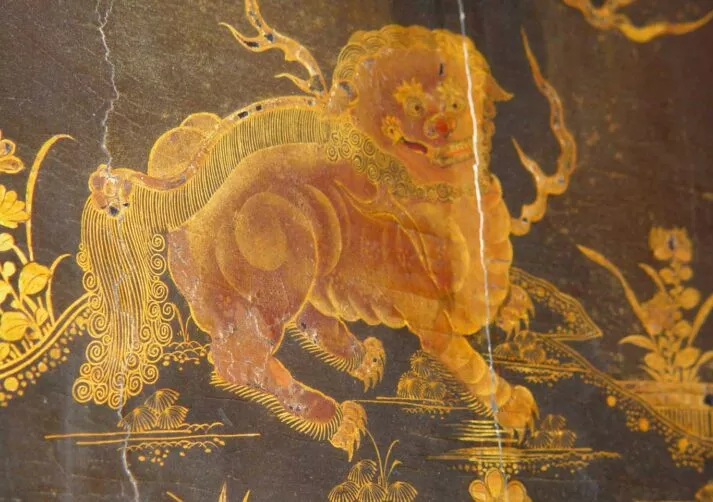
The Elms
Restoring Newport’s Finest Lacquer Room
The oriental-style architectural panels in the Breakfast Room are original to the construction of The Elms. They are the room’s focal point and are enhanced by the restrained Chinoiserie detailing of the room’s sideboards. The Chinoiserie was a western interpretation of Chinese design which became popular in Europe during the late 1600s.
The three main panels are 18th century Chinese (K’ang Hsi Period, 1662-1722) made using authentic oriental lacquer (urushi). The overdoor panels have fragments of urushi and have been restored using European methods (japanning). A fourth large panel was commissioned by the workshops of Jules Allard, possibly by Southeast Asian artisans in Paris.
The panels’ use in this manner is a fascinating 20th century replay of this extremely precious material as it was used in Versailles and other of the great chateaux of France in the 17th and 18th centuries. Very little remains in-situ in France today, though there are fragments (see Bruno Pons, French Period Rooms: 1650 – 1800, p. 35 for an example from the Hotel du Maine and Hugh Honour, Chinoiserie, Pl. 33, for an example from the Hotel d’Evreux, c. 1725). There are examples in Austria that survive in their original locations.
The three large urushi panels are soiled, with degrading waxes and varnishes on the surfaces. There is active and incipient loss to the surface decoration, between the layers of the lacquer itself, and between the lacquer and the substrate. Vertical cracks are apparent due to shrinkage of the wood substrate. The horizontal cracking that has occurred is typical of lacquer.
The panel on the West wall was commissioned around 1900 by Allard et ses Fils of Paris, the firm that was responsible for the Elms interiors. It is in excellent condition and was initially thought to be created using European methods. It has since been discovered to also be oriental lacquer, but possibly crafted by Southeast Asian artisans using lacquer from Southeast Asia rather than China. Scientific analysis will help determine whether this is true.
The overdoor panels have fragments of oriental lacquer, but are mainly constructed using European methods and materials. They are in very poor condition, with abraded varnish, flaking painted decoration, and damaged gesso substrate.
In-house study, supported by The Berwind Fund and John Brooks, was followed by a Getty Foundation grant in 2008 to create a treatment proposal. Additional grants from the Institute of Museum and Library Services, together with support from The Berwind Fund, Felicia Fund, and The E. Rhodes & Leona B. Carpenter Foundation, has allowed us to begin the important conservation work necessary to preserve and lengthen the lives of these internationally-important panels. The work includes stabilizing loose and flaking material, reattaching deformed lacquer, cleaning the surfaces, filling losses, and restoring missing decoration. It will also include efforts to stabilize the climate and minimize light damage in the future.






